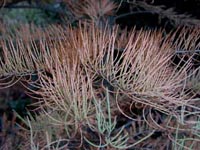Resource Library
Plant of the Week: Pond Cypress
The University of Arkansas System Division of Agriculture does not promote, support or recommend plants featured in "Plant of the Week." Please consult your local Extension office for plants suitable for your region.
Plant of the Week
Pond Cypress
Latin: Taxodium ascendens

If I lived on an acreage at the edge of town, I’d plant lots of trees. But my little lot is already covered with oaks, so the chance to add full-sized trees has been limited to only two. One of these is the pond cypress, a tall, narrow tree that fits my needs perfectly.
Pond cypress (Taxodium ascendens or sometimes listed as a botanical variety of bald cypress, T. distichum var. nutans) is a narrow version of the more familiar bald cypress common in Arkansas’ bayous and wetlands.
Like bald cypress, it’s a deciduous conifer capable of reaching 80 feet tall, but instead of widespread branches found in bald cypress, the pond cypress has a narrow habit, seldom exceeding 15 feet in diameter. The branches arise at right angles to the main bole, creating a very symmetrical form. With age it becomes a living exclamation mark in the landscape.
Up close, pond cypress is one of those plants that calls out to be stroked. The quarter-inch long, needle-like leaves produce erect, 2-inch long leaflets that form down the length of the twiggy branches. In pond cypress, the needles are held tight to the branchlet, giving a kind of rope-like effect, while in bald cypress, branchlets are drooping with a featherlike needle arrangement.
Pond cypress is the last tree to leaf out in my landscape with the bright green needles appearing in late April. In October, the needles turn a coppery-orange.
As a young tree, my pond cypress has been making about 2 feet of growth a year. It’s said not to produce cypress knees, but I’ll have to wait 30 years to confirm that statement.
A cultivar selected in Illinois called ‘Prairie Sentinel’ is listed as a more narrow form. Both the species and its cultivar are difficult to find in local nurseries. Pond cypress ranges in the Gulf Coast states from southern Virginia to Louisiana but not as far north as Arkansas. Though sometimes called the "southern bald cypress," it’s apparently as winter hardy (Zone 5) as the more common bald cypress.
In nature, the pond cypress grows at the edge of the water or in areas that tend to go dry during the summer. Like the bald cypress, standing water is needed for seed germination and survival in the wild, but in landscape situations both species grow fine in average soil conditions.
In a large landscape or park, the narrow, ascending form of the pond cypress would make a delightful plant to mass at the edge of water. In such a grouping, the length of the mass planting should be spread on the ground twice the anticipated future height of the trees. The trees should be arranged informally with gaps in the planting provided to create the illusion of a natural planting.
But, the tall stately form of the tree also makes it suitable for use as a single specimen, something to stand out for its own intrinsic beauty. My pond cypress has had no pest problems, but bagworms and spider mites could attack the tree if conditions were right.
By: Gerald Klingaman, retired
Extension Horticulturist - Ornamentals
Extension News - May 27, 2005
The University of Arkansas System Division of Agriculture does not maintain lists of retail outlets where these plants can be purchased. Please check your local nursery or other retail outlets to ask about the availability of these plants for your growing area.